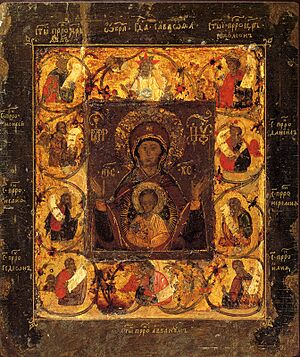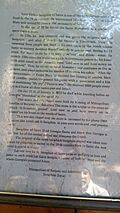Seraphim of Sarov facts for kids
Quick facts for kids SaintSeraphim of Sarov |
|
|---|---|

Russian Icon of Saint Seraphim of Sarov
|
|
| Confessor and Wonderworker | |
| Born | 30 July 1754 Kursk, Russian Empire |
| Died | 2 January 1833 (aged 78) Sarov, Russian Empire |
| Venerated in | Eastern Orthodox Church Anglican Communion Eastern Catholic Church |
| Canonized | 19 July 1903 (O.S.), Sarov Monastery by Holy Governing Synod |
| Major shrine | Diveevo Convent, Russia |
| Feast | 2 January, 19 July (opening of relics) |
| Attributes | Wearing peasant clothing, often kneeling with his hands upraised in prayer; crucifix worn about his neck; hands crossed over chest |
Seraphim of Sarov (Russian: Серафим Саровский) was a very famous Russian saint. He lived from 1754 to 1833. His birth name was Prókhor Isídorovich Moshnín. He is honored in the Eastern Orthodox Church and the Anglican Communion. Many people consider him one of the greatest spiritual leaders of his time.
Seraphim taught that the main goal for Christians was to feel God's presence, also known as receiving the Holy Spirit. He believed that if you found inner peace, you could help many others find it too. A famous quote from him is: "Acquire a peaceful spirit, and thousands around you will be saved." The Russian Orthodox Church officially recognized him as a saint in 1903.
Life of Seraphim
Seraphim was born on July 19, 1754, in Kursk, Russia. He was named Prochor. His parents, Isidore and Agathia Moshnin, were merchants. When he was a young boy, he became very sick. According to church tradition, a special icon of the Virgin Mary called "Our Lady of Kursk" healed him. Seraphim also had several spiritual experiences and visions as he grew up.
In 1777, when he was 19, he joined the Sarov monastery. This is where he began his life as a monk. In 1786, he officially became a monk and was given the name Seraphim. This name comes from the Seraph-angels mentioned in the Bible. He later became a priest for monks. He also became a spiritual guide for the Diveyevo Convent.
Soon after, Seraphim decided to live alone in a small log cabin in the woods. He lived as a hermit for 25 years. During this time, he lived a very strict life. He ate very little, sometimes only vegetables from his garden. For three years, he even ate only grass. His feet became swollen, making it hard for him to walk.
One day, while chopping wood, Seraphim was attacked by thieves. They beat him badly with his own axe handle. He did not fight back. The thieves left him for dead, but they did not find any money. They only found an icon of the Virgin Mary in his hut. Seraphim had a hunched back for the rest of his life because of this attack. However, when the thieves were caught, Seraphim asked the judge to be kind to them. After five months of recovering at the monastery, he went back to his solitary life in the wilderness.
After the attack, Seraphim spent 1,000 nights in a row praying on a large rock. He kept his arms raised to the sky during this time. This was a very difficult spiritual practice. The Eastern Orthodox Church considers this a miraculous act of devotion.
In 1815, Seraphim began to welcome visitors to his hermitage. He did this after a spiritual experience he believed came from the Virgin Mary. He quickly became very popular. People came to him because they believed he had healing powers and could see the future. Hundreds of people visited him daily. They were also amazed because he often knew their questions before they even asked them.
Even though Seraphim was very strict with himself, he was always kind and gentle to others. He would greet his guests by bowing down, giving a kiss, and saying, "Christ is risen!" He also called everyone "My joy." He passed away while kneeling in prayer before an icon of the Virgin Mary. He called this icon "Joy of all Joys." This icon is now kept in Moscow.
Becoming a Saint
In Russia, many people believed that a saint's body should not decay after death. When Seraphim's grave was examined in 1903, his remains had decayed. However, this did not stop him from becoming a saint. Many people, including a church leader named Seraphim Chichagov, strongly supported his sainthood.
In January 1903, the church leaders, with approval from Emperor Nicholas II, announced that Seraphim would become a saint. In July 1903, his remains were moved to a new church. Emperor Nicholas II and his wife, Tsarina Alexandra, even provided a new coffin for them. The official celebration of his sainthood happened in Sarov on July 19, 1903. The Tsar, his wife, and other royal family members attended.
After the celebration, two churches were built and dedicated to Saint Seraphim. One was built over his old cabin in the woods. The second church was built at the Diveyevo convent.
After the Bolshevik Revolution, the Soviet government made it difficult for religious groups. They took away many saints' remains, including Seraphim's. His biographer, Seraphim Chichagov, was later arrested and executed in 1937. He is also honored as a Russian Orthodox saint.
In 1991, Seraphim's remains were found again. They had been hidden in a Soviet museum for 70 years. This was a big event in Russia and for Orthodox Christians worldwide. A large procession carried his remains on foot all the way from Moscow to Diveyevo Convent. They are still there today.
In 2016, some small parts of Seraphim's remains were even launched into space aboard a rocket!
Important Sayings
"It is necessary that the Holy Spirit enter our heart. Everything good that we do, that we do for Christ, is given to us by the Holy Spirit, but prayer most of all, which is always available to us."
Seraphim and Old Believers
There are different ideas about how Saint Seraphim felt about the Old Believers. These were groups of Christians who did not accept certain changes made in the Russian Orthodox Church.
Some stories say that Seraphim supported the church's changes. However, on some pictures of him, he is shown with items often used by Old Believers. For example, he is often seen with a special prayer rope called a lestovka. This lestovka is still kept among his personal items today.
Some people believe that the delay in Seraphim becoming a saint was because he might have been sympathetic to the Old Believers. It has also been suggested that his family might have had connections to Old Believer traditions.
Despite these discussions, the official church stories say that Seraphim did not support the old rites. Many Old Believer writers question the facts known about Seraphim and whether he should have been made a saint.











